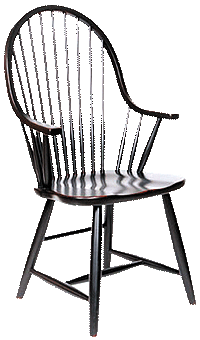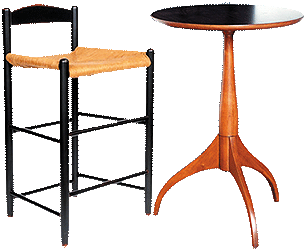- Prelude
- Guest Editor’s Column
- Hard Talk
- Digital Art
- The Write Stuff
- The Art of the Shakers : Shaker Furniture
- New Media
- In the News
- GenNext
- Report
- Artist Index and Statistics
- Market Insight
- Auction Reports
- The month that was
- Mumbai Artsighting
- Musings from Chennai
- Delhi Dias
- Deccan Odyssey
- Art Bengaluru
- In between – from Vadodara
- North-East Opsis
- A Tryst with Art in Madhya Pradesh
- Strands of Social Semiotics
- Transcending Popular
- Art of the Land & Land in Art (part I)
- Through The Patina
- Earth
- Go See India
- Dali's Elephant
- Malleable Memory
- Creative Impulse
- Different hues of Aakriti
- Bonhams : Fine Writing Instruments New York
ART news & views
The Art of the Shakers : Shaker Furniture
Volume: 2 Issue No: 7 Month: 8 Year: 2010
The presence of the art of the Shakers in the world of design is not undeserved, but it is nonetheless strange.  Strange but true: Some of the most enduringly popular American antique furniture was made not by a single designer, but by a group of people who believed in communal living - and no sex. Shaker design did not spring from an adherence to the dictates of fashion, or from the impetus to exploit a market, but form a religious philosophy that wholeheartedly rejected the values of the world at large. Shakerism was a divinely inspired experiment in communal living; almost by accident it generated a genre of designs which have since attained the status of 'art objects'.
Strange but true: Some of the most enduringly popular American antique furniture was made not by a single designer, but by a group of people who believed in communal living - and no sex. Shaker design did not spring from an adherence to the dictates of fashion, or from the impetus to exploit a market, but form a religious philosophy that wholeheartedly rejected the values of the world at large. Shakerism was a divinely inspired experiment in communal living; almost by accident it generated a genre of designs which have since attained the status of 'art objects'.
The origins of the Shaker movement were nothing if not ignominious. Lead by mother Ann lee, who was forced to leave Manchester, England setting sail for New York from Liverpool docks on May 10, 1774. Ann Lee had with her eight followers. She started this movement with this small band of English emigrants. Known derisively as the Shaking Quakers for their frenzied dances and trances during religious services, the Believers (as they called themselves) preached that the path to salvation lay in hard work, abstention from worldly pleasures, and constant prayer. They also practiced celibacy and a cooperative lifestyle, one in which all property was jointly owned. When families joined a Shaker community, husbands parted from wives, and children lived separately from their parents. At its height, the Shaker movement included some 6,000 members, living in 19 villages stretching from Maine to Indiana.
Upon their arrival in the New York, the Shakers were faced with the task of building their own environment.  The completeness that characterizes Shakers settlements, the unity of vision and execution in everything from the humblest oval box to the round barn at Hancock, Massachusetts, or the characteristic granite built meeting houses in other settlements, is an expression of the way Shakerism grew up and realized itself and its philosophies. Shakers literally created their world around them, with watchwords propriety, purity and utility as their guides. That today the Shaker objects are considered to be beautiful and desirable and can fetch high prices at the auctions is a testament to the perspicacity of the Shaker design-makers. In appropriating current vernacular styles for their early furniture and architecture while eschewing the use of unnecessary ornament, the Shakers unwittingly forged the basis of a new aesthetic.
The completeness that characterizes Shakers settlements, the unity of vision and execution in everything from the humblest oval box to the round barn at Hancock, Massachusetts, or the characteristic granite built meeting houses in other settlements, is an expression of the way Shakerism grew up and realized itself and its philosophies. Shakers literally created their world around them, with watchwords propriety, purity and utility as their guides. That today the Shaker objects are considered to be beautiful and desirable and can fetch high prices at the auctions is a testament to the perspicacity of the Shaker design-makers. In appropriating current vernacular styles for their early furniture and architecture while eschewing the use of unnecessary ornament, the Shakers unwittingly forged the basis of a new aesthetic.
The furniture-making Shakers have a great design philosophy, “Do not make something unless it is both necessary and useful; but if it is both necessary and useful; do not hesitate to make it beautiful.” 
 The idea that 'less is more' was encapsulated by the shaker maxims 'beauty rests in utility' and 'every force evolves a form'. In spite of being taken up by a fashionable élite in mid-19th century New York, Shaker furniture survived its subsequent abandonment perhaps because it was never created to pander to vanity, fashion and the vagaries of civilized world. Shaker design came from a world studiedly apart from that of the everyday American in the late 18th and 19th centuries.
The idea that 'less is more' was encapsulated by the shaker maxims 'beauty rests in utility' and 'every force evolves a form'. In spite of being taken up by a fashionable élite in mid-19th century New York, Shaker furniture survived its subsequent abandonment perhaps because it was never created to pander to vanity, fashion and the vagaries of civilized world. Shaker design came from a world studiedly apart from that of the everyday American in the late 18th and 19th centuries.
As they began making furniture (first for their own use, later for sale), Shaker craftsmen principally followed contemporary Federalist styles, like those of Hepplewhite and Sheraton, with their ideals of symmetry, proportion and balance. But they simplified these neo-classical lines even further, to an almost ascetic degree. Mother Ann Lee, the movement's founder, advocated that a piece be made "plain and simple...unembellished by any superfluities which add nothing to its goodness or durability." Instead of intricate inlay, elaborate carving or thick veneers, "the quality of workmanship, sound materials and a smooth finish became the classic elements of Shaker design," noted Jonathan Fairbanks and Elizabeth Bates in American Furniture: 1620 to the Present.
The three P's characterizing the Shakers - plainness, practicality and pride - is reflected in their furniture:
• Woods varied by region, since craftsmen used inexpensive local timber readily available. Common woods: maple, pine, cherry, walnut, hickory (especially for items that required bent pieces) and poplar (especially for interiors).
• Legs are delicate and straight: may be square or round, often tapered or with a gentle swelling in the middle. There are either no feet, or extremely simple bracket feet for case pieces; cylindrical, arrow or pear feet for chairs and tables.
• Prominent fasteners include hand-forged nails and double-pins.
• Construction elements include ball-and-socket feet, mortise-and-tenon joints, dovetailed drawers and frame-and-panel structure.
• Furniture is often painted or stained-typically dark red or green, colors that didn't show dirt; yellow and orange were also used.
• Designed for communal living, many pieces are large: dining tables, chests and sewing tables for two people, but they are often light and compact for portability and easy storage. Tables had drop leaves and legs that unscrewed. Chairs, racks and cupboards were built to be hung on pegs. Often, a Shaker work's beauty lies in its ingenuity.
• Furniture is not without decorative elements, but the decoration is actually part of the structure of a piece. Especially characteristic features: long 'finger joints'; large, plain, button-like or 'mushroom' knobs; and wide slats across chair backs. Chair tops are adorned with acorn-, pinecone- or flame-shaped finials.
Many Shaker specialists consider 1820 to 1865 the 'classical era' of Shaker furniture. After that, the pieces began to evolve, growing more colorful and even reflecting contemporary styles. In these later works:
• Commercially made porcelain knobs replaced wood knobs.
• There's an increased use of contrasting light and dark woods.
• Woven cloth tapes, made of colorful fabrics arranged in checkerboard patterns, replaced the caned backs and seats on chairs.
• Pieces are varnished to accentuate wood grains.
The Shaker communities, as they grew, were forced more and more into interaction with 'the world' in order to ensure some kind of survival. Trade in furniture, brooms, seeds, preserves and other sundries bloomed in the early part of the 19th century, only to be hit 50 years later by the American Civil War. By the mid-to late 19th century the Shaker sect was markedly in decline, with membership falling through a lack of recruits, and the rule of celibacy preventing the creation of a new Shaker generation from within.
In retrospect, it can be seen that the Shakers were probably doomed from an early point in their history. Naively over money matters and several land transactions of a questionable nature cemented the physical demise of the sect as a practical example of communal egalitarianism. Yet, spiritually, Shakerism is still extant. It can be found in the early Shaker objects, the chairs, the buildings which bear testimony to work carried out in the spirit of common good. These are things crafted by hands steadied with the Shakers' surety of faith in their destiny as the chosen people. 'Shakers' today exists as a name of a style. Enshrined within museums and the auction houses and sold from shops with a designer bent, the vernacular tradition purified by the philosophies of Mother Ann Lee is proving to be increasingly popular once more.